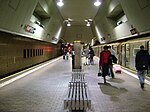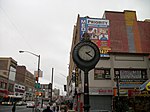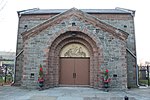St. Monica's Church (Queens)
19th-century Roman Catholic church buildings in the United StatesChurches on the National Register of Historic Places in New York (state)Former Roman Catholic church buildings in New York (state)Jamaica, QueensNew York City Designated Landmarks in Queens, New York ... and 6 more
Properties of religious function on the National Register of Historic Places in BrooklynProperties of religious function on the National Register of Historic Places in Queens, New YorkRoman Catholic churches completed in 1856Roman Catholic churches in Queens, New YorkRomanesque Revival church buildings in New York CityUse mdy dates from September 2022

St. Monica's Church is a historic former Roman Catholic parish church in the Diocese of Brooklyn, located in Jamaica, Queens, New York. It was built in 1856 and is a brick basilica-type building in the Romanesque style. It features a four-story entrance tower in the center of its three-bay-wide front facade. Saint Monica's Church has been refurbished on the Campus of York College as a child care center.
Excerpt from the Wikipedia article St. Monica's Church (Queens) (License: CC BY-SA 3.0, Authors, Images).St. Monica's Church (Queens)
Guy R. Brewer Boulevard, New York Queens
Geographical coordinates (GPS) Address Nearby Places Show on map
Geographical coordinates (GPS)
| Latitude | Longitude |
|---|---|
| N 40.701944444444 ° | E -73.798055555556 ° |
Address
York College the City University of New York
Guy R. Brewer Boulevard
11434 New York, Queens
New York, United States
Open on Google Maps








